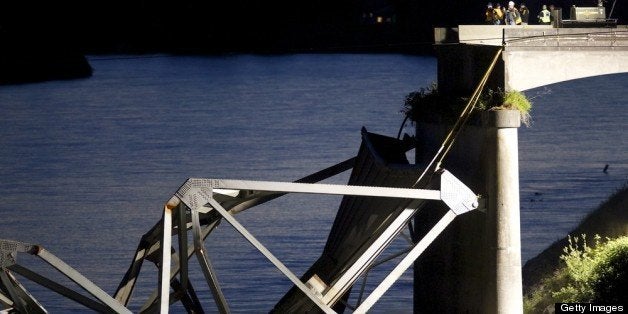
Don't believe austerity can kill you? Then you should feel totally safe driving over our nation's crumbling bridges.
An epic government spending squeeze in the past two years has curbed economic growth, cost millions of jobs, damaged public health and raised the suicide rate. It has also caused a dramatic slowdown in infrastructure spending, raising the threat of many more incidents like Thursday evening's collapse of the Interstate-5 bridge over the Skagit River in Washington.
Fortunately, nobody died in that collapse. Nor has anyone died in any of the six major U.S. bridge failures since the collapse of the I-35 bridge in Minneapolis killed 13 people in August 2007. But this is something of a miracle, considering there are thousands of potentially unsound bridges in the U.S. and a rapidly dwindling amount of money being spent to fix them.
The Skagit River bridge was not even the shakiest bridge in Washington state -- a recent report card of the state's bridges by the American Society of Civil Engineers rated it merely "functionally obsolete," not "structurally deficient," as many other of the state's bridges were rated. More than 750 other bridges in Washington are in worse shape, The Huffington Post's Dave Jamieson reports.
Throughout the U.S. there were more than 150,000 structurally deficient or functionally obsolete bridges in 2012, according to the latest ASCE report card for the nation. The good news is that the number of deficient bridges has actually fallen in recent years. The bad news is that the bridges still in need of repair tend to be bigger bridges that carry more people, according to the ASCE.
"Those bridges that remain classified as structurally deficient are significant in size and length, while the bridges that are being repaired are smaller in scale," the ASCE wrote.
And bridges are probably not even the worst aspect of American infrastructure: The ASCE report card gives U.S. bridges a "C+" grade. Our aviation system, dams, levees, drinking water, waste water disposal, hazardous waste disposal, roads, mass transit, schools and energy systems all received "D" grades.
Maybe we'll get lucky and suffer no deadly disasters as a result of these rotting pillars of our infrastructure. But they are slowly draining the economy of its productivity and vigor. The ASCE estimates that under-spending on infrastructure will cut $3.1 trillion from our gross domestic product by 2020.
America has dropped in the World Economic Forum's global rankings of economic competitiveness for each of the past four years, falling from first in the world to seventh, in part because of its sagging infrastructure. Its global ranking in terms of "quality of overall infrastructure" has dropped from ninth to 25th in the world.
The ASCE estimates that we are spending $157 billion less per year on infrastructure than we need to. And instead of ramping up that spending, we are slashing it. As The Atlantic's Philip Bump points out, infrastructure spending as a percentage of GDP has tumbled to its lowest level in at least 20 years. (Story continues below chart.)
As you can see from the chart, spending on infrastructure surged to above 2 percent of the GDP in the mid-2000s, partly as a function of the housing boom and the rapid development of new neighborhoods. Spending peaked in March 2009, when the Great Recession was still ongoing, and has been falling ever since.
This is precisely the wrong direction, given the ongoing weaknesses in the economy and the state of our bridges, dams and roads.
President Barack Obama has asked at least five times in the past five years for Congress to spend more on infrastructure, The Atlantic notes. But his pleas have been ineffectual. Instead, Congress has been more worried about how to tighten the budget, leading to the sharpest government-spending slowdown since the end of the Vietnam War.
This includes the $85 billion in brutal federal budget cuts of the sequestration, which threatens to cut billions of dollars from government spending on construction.
Austerians, inspired partly by discredited research, argue that too much government spending now will crush economic growth in the future. But more government spending on the upkeep of our economy's muscle, blood, bones and nerves would likely boost economic growth now and in the future.
In the meantime, expect more of us to develop gephyrophobia.
